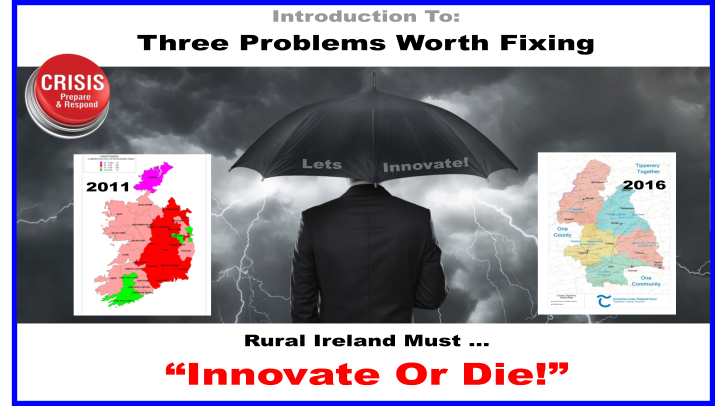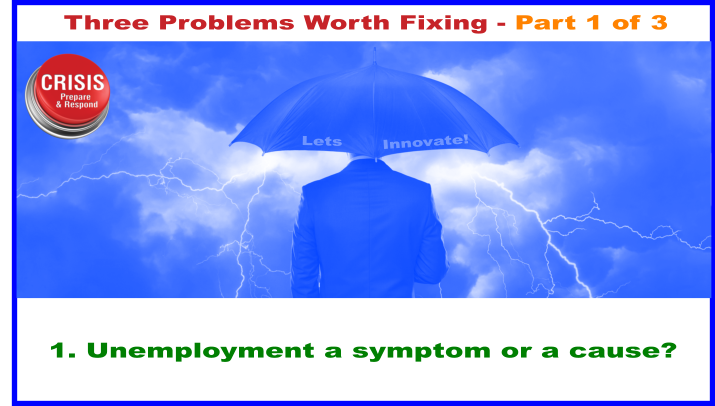
Rural Ireland Must … “Innovate Or Die!”
Rural Ireland must … Innovate Or Die!. This may sound a little over dramatic until you make a connection as I did recently. I was conducting research for a thought experiment which forms the basis for my masters. My thesis is framed as a question, “How can lean innovation create shared value?”. What was more surprising was how my journey would first begin in my own community of county Tipperary in Ireland. On route, I found myself drawing parallels with Japanese small town communities. These small town communities are struggling to rebuild 5 years after the disasters of 311 (March 11th 2011). I had found myself a long way from Tipperary.
All journeys begin at home
What follows is some of the research I encountered on route. I will explore a landscape of possible opportunities for further innovation before journeys end. As with all journeys, we must begin ours in my local community in county Tipperary, Ireland. I began my early research by seeking out measurable data which would size two of the three big problems worth fixing. The three big problems I had identified would require even bigger solutions.
From job seekers gaining a foot hold …
Persistently high unemployment rates and shrinking town centre footfall may be signally the slow demise of rural living in small town Ireland. Nine such towns in county Tipperary are now being called to action to combine their common shared social and commercial interests. This unprecedented collaboration will seek to focus efforts on enhancing town centre shared value creation for mutual and wider community gain. The initial key objectives are to reverse the decreasing downward trend of falling consumer footfall.

Image Source: Tipperary County Council – Town Centre Initiatives
To … falling consumer footfall is now consuming small town business
The majority of small and micro businesses in town centres rely on all year round retail sales from local consumers to sustain a level of viability and fight off job losses and closure. Some estimates suggest that rural unemployment within the ranks of local consumers could be in excess of 20% in many county Tipperary towns and villages. The interdependent relationship of town centre businesses and full time employed local consumers could be viewed as a symbiotic relationship.
In a globalised world of on-line shopping, suburban retail parks and long distance shopping, the falling footfall in town centre retail outlets may be signally the need for major change in rural Ireland. This major change may require creative innovative thinking on a scale only matched by the size of the problems to be overcome.
Climbing mountains of research but where’s the data?
I hypothesised that the problems of rural Ireland are unlikely to be unique. It has been widely suggested that the unemployment rates are higher in county Tipperary than the national average rates for unemployment. It has also been widely written about that most small town centres in rural Ireland are now in decline. Retail experts claim that town centre retail business declines are in-line with declining consumer foot fall. But where is the data to support such conclusions?
Ask and you shall receive
It was time to call on the search expertise of Mr Google. Mr Google sat ready on my computer screen so I politely queried him. I wanted to skim the surface, be lazy and just ask if he knew about community sustainability in the face of extreme adversity. I had hope to find existing publications, books or articles on the topic. It was my intention to return later and take a deeper dive as a part of my search for valuable factual data worthy of citation. I was hoping to avoid drowning neck deep in academic journals, research papers and databases. I was looking for a more agile approach to capturing a quick snapshot of the entire landscape of rural Ireland at this very early stage of my journey.
Be careful what you wish for …
As I thrashed around an ocean of results I made a mad grab for a news segment on YouTube which was just showing above the waterline. Little did I know that it would drag me around the world to a small town called Naraha in Japan. Naraha like many other small rural towns in Japan had first faced a magnitude 9 earthquake and then the tsunami on March 11th 2011. On March 12th many of the people of Fukushima region including the population of Naraha faced a yet another disaster. Together they would bring the total in excess of 200,000 refugees who were forced to quit their homes, lives, communities, towns and villages and instead take flight from the worst nuclear disaster on record.
Unsustainable limits in the face of overwhelming adversity
5 years later less than 40% of the refugee hold out hope of ever returning home. These towns now mostly devoid of there population have little of there former commercial or social value to attract their displaced communities to return home. Without their people returning to bring life back to these once vibrant culture rich towns and villages, what once was and what remains may be lost forever. Sadly, my lazy search had turned up the most extremes of adversity of countless communities pushed beyond their limits in the face of overwhelming adversity. Another question came to mind, in the face of such adversity, given such a challenge … it must be possible to rebuild … here was another problem worth fixing and the real question now would be how?
Innovating from Nenagh to Naraha …
I would like to suggest that Clonmel, Nenagh, Thurles, Carrick-on-Suir, Roscrea, Tipperary, Cashel, Cahir and Templemore are not unlike many other small rural towns in Ireland. Rural towns need to add individualised commercial and social value if they are to reverse the declining consumer trend and population. The Japanese small town communities of Futaba, Litate, Katsurao, Kawamata, Namie, Tomioka, Hirono, Okuma, Minamisoma, Naraha, Kawauchi, Tamura are today now facing the most extremes of such problems. This towns require an entirely new higher level of frugal innovative thinking if local economic and community development are to successfully take root, grow and become self sustaining into the future.
Rural Ireland may be on the decline to something resembling small town America, but rural Japan takes the shared challenges of building value into our towns and communities to entirely new levels. Each must address similar problems at different extremes if they are to sustain and grow. Perhaps these similar problems share similar solutions. Perhaps all may even share the same approach to solving such problems. How to deliver the needed commercial value and social gain? How to realise new opportunities in the face of adversity and ignite new local economic development in our rural towns and villages. How to increase sustainable local employment? How to create greater local consumer foot fall in local town centre businesses. When taken as a whole, the sum of all job creation, business growth and community development and sustain a partnered commercial and social community for the greater shared good and mutual benefit of all?
More questions than solutions … are we really up to the challenge?
Solving problems worth fixing
From Job Seekers in county Tipperary and small Irish towns in declining rural communities to 200,000 displaced Japanese refugees fighting to rebuild their lives, families, communities and towns … it is apparent to me that each of these three problems are big problems worth fixing. A bigger problem maybe that they require an even greater fundamental transformational change in current thinking in order to successfully scale or navigate around such problems if real social and commercial shared value is to be realised.
Each problem will require new high value low waste frugal problem solving solutions. As high commercially valuable solutions they must also be sustainable and substantive in social gain. They must also be simple, effective, efficient and respectful of the individual, community and planet. Such solutions must be lean, simple, sustainable, clean, respectful and social in word and deed. In short, the solutions will need to be frugally innovative.
These three problems form the basis for a series of three posts. I hope you will join me on my research journey. Our destination is to better understand the scale of the problems challenging every rural commercial and social small town community.
These small towns can be found throughout rural Ireland, Japan and most countries around the globe including small town USA. How can they rise to the challenge and hear the call to action … “Collaborate to Innovate”? … unfortunately most may already be facing into a new future reality and greater challenge to “Innovate or die!”.
Here’s the first of three thought challenging posts in this three part series called:
(Problem 1: Unemployment a symptom or a cause?)
Lets Innovate!
[Legal]
[AboutMe]

An Ocean of GDPR Data Streams

The internet of everything?

GDPR or Bust!

Breaking Brexit

Lean is Green not Mean

How Can VoC Work For Micro Firms?

Battle cry goes out to small businesses – it’s time to innovate

Lean Innovating A New Manufacturing Service

Leaning Into Services
[SocialNetworks]








<<< Other Related On-line Resources >>>
Visit: Over €220 million will be spent on rural programmes by 2020 – how much is your county getting?
Source: TheJournal.ie
Visit: Look at them now: This rural town has turned its fortunes around after last year’s blow
Source: TheJournal.ie
Visit: Rural Ireland is dead and gone, it’s with O’Leary in the grave.
Source: Politics.ie
Visit: State can’t afford rural Ireland – Moran
Source: Independent.ie
Visit: Pat Spillane: ‘Last chance saloon near for rural Ireland’
Source: IrishExaminer.com
Visit: Research Report of Commission on the Economic Development of Rural Ireland
Source: Teagasc.ie
Visit: Department of Housing, Planning, Community and Local Government – The Rural Development Programme (LEADER Axes)
Source: Gov.ie
Visit: Lack of respect for communities in rural Ireland
Source: SVP.ie
Visit: Government neglect killing rural Ireland, priests warn
Source: IrishCatholic.ie
Visit: Tonight with Vincent Browne – Rural Funding (Begins at:15 minutes in)
Source: TV3.ie
Visit: Skibbereen’s new digital hub hopes to be template for rural Ireland
Source: IrishTimes.com
Hi John Horkan, thanks for sharing! … as each rural town seeks to build an individual brand, inviting greater visitor experience and community engagement this is indeed a great innovation opportunity. Its also a great opportunity to listen to the voice of the customer and respond with new added value for consumers and the wider community. Calling everyone to action to raise the town brand profile by challenging all to bring forward new, creative and innovative ideas which create commercial value and social gain as local collaborative partnerships. Grow business, empower employment and sustain communities. Having read the full post on my blog … I wondered with all your experience would you share your thoughts on how local small business and community in partnered projects could build brand and add value for local consumers in today’s rural Ireland?
In problem two of three problems worth fixing I quote from a recent public town hall meeting in Tipperary Town. During the meeting a member of the often animated audience suggests that nearly 20% of town centre shops have closed since the recession began in 2008.
I feel confident that many small towns and villages in rural Ireland perhaps share this unwelcome devaluing experience for visitors encountering boarded up businesses. Your suggestion is an excellent one. Building on your suggestion, I believe it can be possible to team with major commercial paint manufacturers, corporate sponsors and local tidy town groups who in partnership facilitate the required sponsored materials and volunteer labour under a banner of corporate social responsibility and community partnership.
Assuming that this may already be the case, perhaps building on your ideas further a little innovation could go along way. I wonder if a possible partnership between local estate agents and county councils of vacant properties could team up with local community groups to renew this empty often boarded up store fronts and instead fill them with tastefully town presentations of local commercial, community and tourist information, offerings, attractions and events?
As a child growing up in the early 70’s in the urban cities of Coventry and Birmingham, I also reflect most affectionately to a time when the common practice was to fill every window commercial and domestic with winter wonderlands.
They often were miniature sights, scenes and sounds from our neighbourhood nearly always cloaked in snow. They not only included the local locations they often included local characters that we loved and knew like the ‘rag-and-bone’, ‘coal’ or ‘milk’ man. The hours spent walking up and down each and every street in our local area just soaking up every last drop of this wonderful colourful and creative experience made the hours fade into moments. This was one of my fondest family memories of communities and visitors sharing together a heart warming experience. Everyone got evolved. It was a celebration of community where people turned outwards to share their local pride and perceptions of local value with their collective neighbourhood and the unselfish benefit of others in their local community.
To this day I fail to understand why we had to wait until the annual xmas period and why we could not enjoy this community experience all year round.
It sure would beat looking at empty windows, bland painted hoarding or boiler plate blatant advertising!
Please note that the first of the three problems worth fixing is ‘ Unemployment a symptom or a cause? (Part 1 of 3) June 16, 2016 ‘ and available here!
Small towns and rural areas all have inherent community cultures and identities. It is the level of which the value is visible and available. It also is the possible level of transfer, association or creation of new value that helps to build and grow an existing town offering and brand. Another level of importance is the level of collaboration, integration and shared interest between social and commercial sectors.
The greater the collaboration to create ‘Shared Value’ the greater the opportunities for frugal innovation. The greater the ‘Shared Value’ created and its ease of accessibility by all members of the community the greater the appeal for new members to join the community and contribute to local business and social success. The Canadian model of facilitating new community members maybe an excellent example of commercial and social partnered ‘Shared Value’ in local economic development.